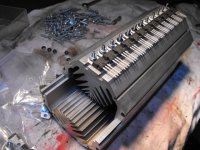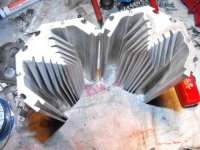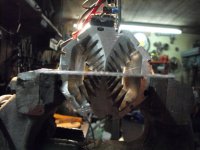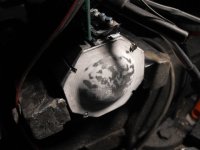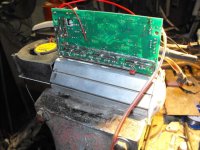I don't know enough about phase current relationships to battery current but at 150A, you have 13.88W just in that one bank of 6 FETs. I think there's an error in your calculation of P(36).
But, you can't use 3.7mOhm for the Rds(on)!
That's only a typical value for a FET at room temperature. Some FETs may have a higher value, and others lower. A good cooling system design will use the max. Rds(on) to either take into account a batch of FETs that have typical values near to max. or help provide a bit of a safety margin for the cooling system in case the system's efficiency ever goes down (dust in the fan(s), deposits inside liquid cooling pipes, higher ambient temperature, etc.).
You can calculate the power levels for both typical and max, if desired, to see the range of power levels and decide on what safety margin to include in the design.
Soooooo....
Assuming a 100C junction temperature, and using the Normalized On-Resistance vs. Temperature graph in the IRFB4110 datasheet, the typical Rds(on) = 3.7mOhm x 1.65 = 6.1mOhm. The max. is 4.5mOhm x 1.65 = 7.4mOhm.
But, I think 100C is wayyyyyy too low an actual-use number for just about any controller used by you guys so let's use the 175C junction temperature.

That sets the typical Rds(on) = 3.7mOhm x 2.5 = 9.3mOhm and the max = 4.5mOhm x 2.5 = 11.3mOhm
Calculating the power at 100C...
P(6) power levels using six "typical" FETs = (.0061 / 6) x 150 x 150 = 22.88W
P(6) power levels using six "max Rds(on)" FETs = (.0074 / 6) x 150 x 150 = 27.75W
Calculating the power at the more likely 175C junction temperature...
P(6) power levels using six "typical" FETs = (.0093 / 6) x 150 x 150 = 34.88W
P(6) power levels using six "max Rds(on)" FETs = (.0113 / 6) x 150 x 150 = 42.38W
You can see the huge jump in power levels from the 13.88W value calculated when assuming all the FETs will be "typical", at room temperature, to the power that needs to be handled at 175C, 34.88W. That's about a 250% increase!!!
If assuming a worst case (IMHO, always prudent, especially when operating at near the max ratings), it's a 305% increase in power you need to deal with at 175C!
[Edit] The above assumes 100% throttle (i.e., no switching of the FETs). Your 50% throttle power loss calculations will have to take into account the switching losses as well as the R(ds) on losses. The switching losses may or may not be lower. It depends on the FETs, driver voltage, and driver current, blah, blah.



